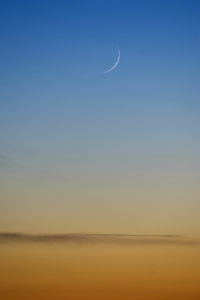The timing of Eid al-Fitr and Ramadan and other holidays in the Islamic calendar can be hard to pinpoint exactly, because they depend on the sighting of the new crescent moon. Tonight, driving home from West Palm Beach along the lagoon, Seth pointed out the crescent moon on the western horizon, and once we crossed the canal into Lake Worth, I could see it, too. Which reminded me: for our friends observing Ramadan (like Tari and Sami, who run The Pelican restaurant downtown), Ramadan was now over, and it was time to celebrate Eid al-Fitr.
Eid al-Fitr is a three-day celebration that concludes Ramadan, the month of fasting. It is a time of prayer but a time of abundance, with good food and good aromas and good company and good deeds. It is a time meant to bring out the best in people. It begins with the sighting of the new moon’s first faint crescent, which, this year, at least in North America, was expected to be tonight, the 5th of July. Elsewhere in the world, Eid al-Fitr will begin tomorrow, on the 6th. Being a lunar holiday, the dates are not fixed in our Gregorian calendar, which is a solar calendar. A good lesson, perhaps, in being in the moment.
Customs vary widely from country to country, but charity and prayer, respect to others, and food, especially sweets, are at the forefront. And, of course, wishing all we meet Eid Mubarak: a blessed Eid.
Image: “34 Hours After New Moon” by Mika-Pekka Markkanen, a photograph shot at Järvenpää, Finland, May 26, 2009. [Public domain] via Wikimedia Commons.
